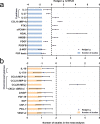A systematic review and meta-analysis of inflammatory biomarkers in Parkinson's disease
- PMID: 36739284
- PMCID: PMC9899271
- DOI: 10.1038/s41531-023-00449-5
A systematic review and meta-analysis of inflammatory biomarkers in Parkinson's disease
Abstract
Neuroinflammation plays a crucial role in the pathogenesis of Parkinson's disease (PD), but controversies persist. Studies reporting concentrations of blood or cerebrospinal fluid (CSF) markers for patients with PD and controls were included and extracted. Pooled Hedges'g was adopted to illustrate comparisons, and covariates were used to explore sources of heterogeneity. Finally, 152 studies were included. Increased IL-6, TNF-α, IL-1β, STNFR1, CRP, CCL2, CX3CL1, and CXCL12 levels and decreased INF-γ and IL-4 levels were noted in the PD group. In addition, increased CSF levels of IL-6, TNF-α, IL-1β, CRP and CCL2 were revealed in patients with PD compared to controls. Consequently, significantly altered levels of inflammatory markers were verified between PD group and control, suggesting that PD is accompanied by inflammatory responses in both the peripheral blood and CSF. This study was registered with PROSPERO, CRD42022349182.
© 2023. The Author(s).
Conflict of interest statement
The authors declare no competing interests.
Figures





References
Publication types
LinkOut - more resources
Full Text Sources
Research Materials
Miscellaneous

